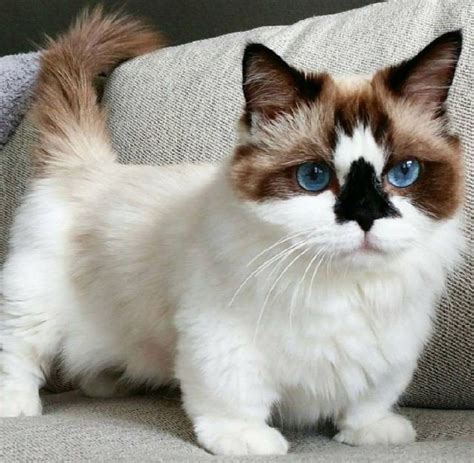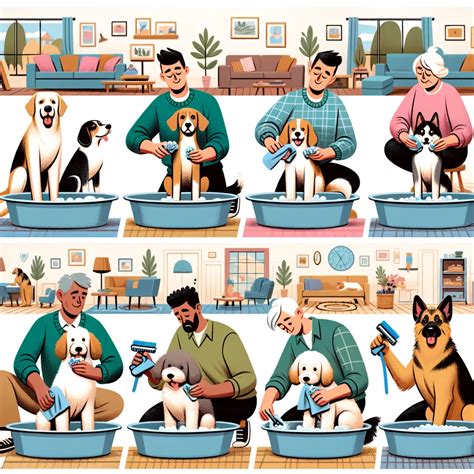
A Munchkin cat named Bean and a baby bunny rabbit have captured hearts online with their unlikely and undeniably sweet friendship. Their owner regularly posts videos and photos of the pair’s heartwarming interactions, showcasing their bond and bringing joy to viewers worldwide.
Bean, the Munchkin cat with distinctive short legs, and the unnamed baby bunny have become internet sensations due to their affectionate companionship. Their owner, who manages their social media presence, highlights their daily routines, playful moments, and tender cuddles, creating a delightful narrative of interspecies friendship. The videos and photos, shared across platforms like Instagram and TikTok, have garnered significant attention, attracting a large following of animal lovers. The duo’s charm lies in their natural connection, providing a heartwarming reminder of the simple joys of companionship.
The popularity of Bean and the bunny underscores a broader trend of animal friendships capturing public attention. In a world often characterized by division and conflict, these heartwarming stories serve as a comforting reminder of unity, affection, and the ability to find common ground across species. The appeal of their relationship lies in its simplicity and authenticity, offering a refreshing antidote to the complexities of modern life.
The heartwarming bond between Bean and the bunny provides a much-needed dose of positivity in the digital landscape, resonating with a global audience eager for uplifting content. Their story highlights the power of interspecies connections and the universal appeal of friendship.
The Rise of Interspecies Friendships on Social Media
Interspecies friendships have increasingly become a popular subject on social media, with numerous accounts dedicated to showcasing the unique bonds between different animals. These accounts often feature heartwarming videos and photos that capture the animals’ playful interactions, affectionate moments, and genuine companionship. The appeal of these friendships lies in their ability to transcend the perceived boundaries between species, highlighting the universal capacity for love, empathy, and connection.
Several factors contribute to the rise of interspecies friendships on social media. First, the internet has made it easier than ever to share and discover content from around the world. This has led to a greater awareness of the diverse relationships that exist between animals, both in captivity and in the wild. Second, social media platforms like Instagram, TikTok, and YouTube provide a visual medium for showcasing these friendships in an engaging and accessible way. The short-form video format, in particular, is well-suited for capturing the playful and affectionate moments that characterize these bonds. Third, in an era of increasing social isolation and digital disconnection, interspecies friendships offer a comforting and heartwarming reminder of the power of connection. These friendships provide a sense of hope, joy, and optimism, reminding us that love and companionship can be found in unexpected places.
Examples of other famous interspecies friendships include:
- Bubbles the African elephant and Bella the black Labrador: These two unlikely friends formed a close bond at a wildlife preserve in South Carolina. Bubbles, who was rescued from ivory poachers, and Bella, who was abandoned at the preserve, became inseparable, playing together in the water and sharing meals.
- Milo the dachshund and Baloo the bear: These two friends live at a wildlife sanctuary in California. Milo, the dachshund, helps take care of Baloo and keeps him entertained, while Baloo provides Milo with companionship and protection.
- Kate the Great Dane and Pippin the fawn: These two friends live at a home in Kentucky. Kate, the Great Dane, adopted Pippin when she was just a few days old. They play together, sleep together, and are always there for each other.
- Tinni the wild fox and Sniffer the dog: A photographer in Norway documented the heartwarming friendship between Tinni the wild fox and Sniffer the dog. Their interactions showcased the beauty of nature and the potential for kindness between wild and domestic animals.
These are just a few examples of the many interspecies friendships that have captured the public’s imagination. These friendships remind us that love and companionship can be found in unexpected places and that the bonds between animals can be just as strong as those between humans.
Munchkin Cats: A Breed Overview
The Munchkin cat, known for its distinctive short legs, is a relatively new breed that has gained popularity in recent years. This unique physical trait is the result of a genetic mutation that affects the length of the long bones in the legs. While some find the Munchkin cat’s appearance endearing, the breed’s health and welfare have been the subject of debate among veterinarians and animal welfare organizations.
The Munchkin cat was first recognized as a distinct breed in the 1990s. The breed’s name is derived from the Munchkins in L. Frank Baum’s novel The Wonderful Wizard of Oz. The short legs of the Munchkin cat are caused by a genetic mutation known as achondroplasia, which is a form of dwarfism. This mutation affects the growth of the long bones in the legs, resulting in shorter limbs compared to other cat breeds.
Despite their short legs, Munchkin cats are generally active and playful. They are known for their ability to run, jump, and climb, although their range of motion may be limited compared to cats with longer legs. Munchkin cats are also known for their friendly and outgoing personalities, making them popular pets.
The health and welfare of Munchkin cats have been a subject of debate among veterinarians and animal welfare organizations. Some argue that the breed’s short legs can lead to health problems such as arthritis, spinal problems, and joint pain. Others argue that Munchkin cats are generally healthy and that their short legs do not significantly impact their quality of life.
Several studies have investigated the health of Munchkin cats. One study, published in the Journal of Feline Medicine and Surgery, found that Munchkin cats are more likely to develop osteoarthritis than other cat breeds. The study also found that Munchkin cats are more likely to have spinal problems, such as lordosis (an abnormal curvature of the spine).
Another study, published in the Veterinary Record, found that Munchkin cats are not more likely to develop hip dysplasia than other cat breeds. However, the study did find that Munchkin cats are more likely to have patellar luxation (dislocation of the kneecap).
Despite the potential health problems associated with the Munchkin cat breed, many people find them to be loving and rewarding pets. Owners of Munchkin cats often describe them as playful, affectionate, and intelligent animals.
The ethics of breeding Munchkin cats remains a controversial topic. Some animal welfare organizations argue that breeding animals with genetic mutations that can cause health problems is unethical. Others argue that breeders can minimize the risk of health problems by carefully selecting breeding pairs and monitoring the health of their cats.
Caring for a Baby Bunny
Baby bunnies, also known as kits, require specialized care to ensure their survival and well-being. Whether orphaned or raised domestically, understanding their unique needs is crucial for responsible pet ownership or wildlife rehabilitation.
Young rabbits, especially those separated from their mothers, depend heavily on proper nutrition. Commercial rabbit milk replacers are available, but in emergency situations, goat’s milk can be used as a temporary substitute. Feeding should be done with a syringe or small pet nurser, mimicking the natural nursing process. The frequency and amount of feeding depend on the age and weight of the bunny, with newborns requiring more frequent meals than older kits. It’s essential to avoid overfeeding, which can lead to digestive problems.
Temperature regulation is another critical aspect of caring for baby bunnies. Kits are unable to regulate their own body temperature for the first few weeks of life and rely on their mother’s warmth. In the absence of a mother, a heat source such as a heating pad or a heat lamp should be provided. The temperature of the enclosure should be maintained at a comfortable level, typically around 85-90°F (29-32°C) for newborns, gradually decreasing as the bunny grows older. It is important to monitor the bunny’s behavior for signs of overheating or chilling and adjust the temperature accordingly.
Hygiene is also essential for preventing illness in baby bunnies. The enclosure should be kept clean and dry, with regular changes of bedding. Kits are unable to urinate and defecate on their own for the first few weeks of life and require stimulation from their mother to do so. In the absence of a mother, this can be accomplished by gently stroking the bunny’s genital area with a damp cloth. This should be done after each feeding to encourage elimination.
As baby bunnies grow older, they can be gradually introduced to solid foods such as hay, pellets, and fresh vegetables. Timothy hay should be provided as a primary food source, as it is high in fiber and helps to maintain healthy digestion. Rabbit pellets should be offered in limited quantities, as they are high in calories and can lead to obesity. Fresh vegetables such as leafy greens, carrots, and broccoli can be offered in small amounts, but it’s important to avoid vegetables that are high in sugar or starch.
Socialization is also important for baby bunnies, especially those that will be kept as pets. Handling and interacting with the bunny from a young age can help to build trust and create a strong bond. Bunnies should be handled gently and with care, as they are delicate animals. It’s also important to provide the bunny with opportunities to explore and play in a safe and stimulating environment.
Caring for baby bunnies can be challenging, but it is also a rewarding experience. By providing proper nutrition, temperature regulation, hygiene, and socialization, you can help to ensure that these delicate animals thrive.
Impact on Social Media and Viewer Engagement
The popularity of Bean and the bunny underscores the power of social media to amplify heartwarming stories and connect people through shared emotions. Their presence on platforms like Instagram and TikTok has created a community of followers who find joy and comfort in their daily interactions. This engagement highlights the growing demand for positive and uplifting content in an often-negative online environment.
The way viewers interact with content featuring interspecies friendships can be analyzed through several metrics. These include likes, shares, comments, and saves, which collectively indicate the level of engagement and emotional resonance. Comments often express admiration for the animals’ bond, gratitude for the positivity they bring, and personal anecdotes about similar experiences or desires. Shares extend the reach of the content, introducing it to new audiences and amplifying its impact. Saves indicate that viewers want to revisit the content, suggesting that it provides ongoing comfort or inspiration.
The algorithms of social media platforms play a significant role in determining the visibility of such content. Algorithms prioritize content that is likely to generate engagement, which means that heartwarming stories like that of Bean and the bunny are often promoted to a wider audience. This creates a positive feedback loop, where popular content becomes even more popular, further amplifying its reach and impact.
The success of Bean and the bunny also reflects a broader trend of using social media for emotional connection and support. In an era of increasing social isolation and digital disconnection, many people turn to online communities to find a sense of belonging and shared experience. Accounts featuring interspecies friendships provide a safe and positive space for people to connect, share their love of animals, and find comfort in the simple joys of companionship.
Ethical Considerations
While the story of Bean and the bunny is undoubtedly heartwarming, it also raises some ethical considerations regarding animal welfare and responsible pet ownership. It is important to examine these issues to ensure that the animals’ well-being is prioritized and that their story does not unintentionally promote harmful practices.
One of the primary ethical concerns is the breeding of Munchkin cats. As mentioned earlier, the short legs of Munchkin cats are caused by a genetic mutation that can lead to health problems such as arthritis, spinal problems, and joint pain. Some animal welfare organizations argue that breeding animals with genetic mutations that can cause health problems is unethical and that it prioritizes human preferences over animal welfare.
Another ethical concern is the keeping of rabbits as pets, particularly baby bunnies. Rabbits are complex animals with specific needs, and they are often misunderstood and mistreated. Baby bunnies are especially vulnerable, as they require specialized care and attention. It is important to ensure that potential rabbit owners are fully aware of the responsibilities involved in caring for these animals and that they are committed to providing them with a safe, healthy, and enriching environment.
Additionally, it is important to consider the potential impact of social media on animal welfare. While social media can be a powerful tool for raising awareness about animal issues and promoting responsible pet ownership, it can also be used to exploit animals for entertainment purposes. It is important to ensure that animals are not being harmed or stressed for the sake of creating content and that their well-being is always prioritized.
The Enduring Appeal of Animal Companionship
The story of Bean and the bunny speaks to the enduring appeal of animal companionship. Throughout history, humans have formed deep and meaningful bonds with animals, finding in them not only practical assistance but also emotional support, unconditional love, and a sense of connection to the natural world.
Animals have played a variety of roles in human societies, from working animals that provide labor and transportation to companion animals that offer comfort and companionship. In many cultures, animals are revered as symbols of power, wisdom, or spirituality. The bond between humans and animals is deeply rooted in our history and culture.
In modern society, companion animals play an increasingly important role in the lives of many people. Pets provide companionship, reduce stress, and promote physical activity. Studies have shown that pet ownership can lower blood pressure, reduce cholesterol levels, and improve overall cardiovascular health. Pets can also provide a sense of purpose and meaning, particularly for people who live alone or who are experiencing difficult life circumstances.
The story of Bean and the bunny reminds us of the power of animal companionship to bring joy, comfort, and connection to our lives. It is a reminder that love and friendship can be found in unexpected places and that the bonds between humans and animals can be just as strong as those between humans. The friendship between Bean and the bunny is more than just an internet sensation; it is a testament to the enduring appeal of animal companionship and the power of love to transcend species boundaries.
Frequently Asked Questions (FAQ)
- What makes the friendship between Bean and the bunny so special?
The special aspect of their friendship lies in its unexpected nature and the genuine affection they display for each other. Viewers are touched by the simple joy and comfort they find in each other’s company, transcending species barriers. The videos and photos showcase a pure and uncomplicated connection, providing a heartwarming escape from the complexities of daily life. Their interactions highlight the universal themes of companionship, empathy, and the ability to form meaningful relationships regardless of differences.
- How did Bean and the bunny come to live together?
The article does not explicitly state how Bean and the bunny came to live together. However, it can be inferred that their owner intentionally brought them together, possibly for companionship, and has been documenting their interactions on social media. More details about the precise circumstances would require further information from their owner.
- Are there any risks associated with housing a cat and a rabbit together?
Yes, there are potential risks. Cats are natural predators, and even a friendly cat could unintentionally harm a rabbit, especially a baby bunny. Supervision is crucial to ensure the cat’s playful behavior doesn’t turn aggressive or cause accidental injury. The size difference can also be a factor, where a larger cat may unintentionally injure a smaller rabbit. It is vital to introduce them slowly and carefully, providing separate safe spaces and monitoring their interactions closely.
- What kind of care do Munchkin cats require due to their short legs?
Munchkin cats, due to their short legs, may require some modifications to their environment. They may have difficulty jumping onto high surfaces, so providing ramps or steps can help them access their favorite spots. Regular vet checkups are essential to monitor for potential joint or spinal issues. Maintaining a healthy weight is also important to minimize stress on their joints. Despite their short legs, they are generally active and playful but may need extra care to ensure they can move comfortably and safely.
- Where can I find more information about responsible pet ownership for both cats and rabbits?
Information on responsible pet ownership can be found through various resources. The American Society for the Prevention of Cruelty to Animals (ASPCA) and the Humane Society offer guidelines on cat and rabbit care. Reputable breeders and veterinarians can also provide valuable advice. Additionally, numerous books and online resources detail the specific needs of each species, including diet, housing, health, and socialization, to help owners provide the best possible care for their pets.
- How does social media affect our perception of animal friendships?
Social media can significantly shape our perception of animal friendships by presenting curated and often idealized versions of these relationships. While it can raise awareness and promote positive interactions, it can also create unrealistic expectations. The “cuteness overload” phenomenon can sometimes overshadow the real needs and complexities of caring for animals. Additionally, the pressure to create engaging content can potentially lead to the exploitation or mistreatment of animals, highlighting the need for responsible and ethical content creation.
- What is the best way to introduce a cat and a rabbit to each other?
Introducing a cat and rabbit requires a slow and careful approach. Start by keeping them separate in different areas of the house, allowing them to get used to each other’s scents. Gradually introduce them in a controlled environment, such as a neutral room, for short periods. Always supervise their interactions closely and ensure the rabbit has a safe space to retreat to. Reward calm and positive behavior with treats and praise. Never force interactions, and allow them to adjust at their own pace.
- Are there any specific toys or activities that are particularly suitable for both cats and rabbits?
While cats and rabbits have different play styles, some toys and activities can be enjoyed by both. Puzzle toys that dispense treats can engage their minds. Tunnels and boxes provide hiding places and opportunities for exploration. Balls and other toys that can be chased are also popular. However, it’s essential to choose toys that are safe for both species, avoiding small parts that could be ingested. Interactive play sessions with their owner can also help strengthen their bond and provide enrichment.
- What are the potential health issues that Munchkin cats are prone to, and how can they be prevented or managed?
Munchkin cats are prone to several health issues due to their genetic mutation, including osteoarthritis, spinal problems (such as lordosis), and joint pain. Prevention and management involve regular veterinary checkups to monitor for early signs of these conditions. Maintaining a healthy weight is crucial to reduce stress on their joints. Providing a supportive environment with ramps and soft bedding can help them move comfortably. Nutritional supplements, such as glucosamine and chondroitin, may be recommended by a veterinarian to support joint health. In some cases, pain medication may be necessary to manage discomfort.
- What are some common misconceptions about keeping rabbits as pets, and what is the reality?
Common misconceptions about rabbits include that they are low-maintenance pets, that they can live in small cages, and that they are happy being alone. The reality is that rabbits require significant care and attention. They need spacious enclosures, regular exercise, a balanced diet, and social interaction. They are intelligent and social animals that thrive on companionship and enrichment. They also require regular vet care and can be prone to various health issues if not properly cared for.
- How do animal friendships like Bean and the bunny’s contribute to our understanding of animal behavior and emotions?
Animal friendships provide valuable insights into animal behavior and emotions, demonstrating that animals are capable of forming complex social bonds and experiencing a range of emotions, including affection, empathy, and companionship. These relationships challenge anthropocentric views that limit animals’ emotional and social capacities. By observing and studying these friendships, we can gain a deeper understanding of the cognitive and emotional lives of animals and appreciate the diversity of social relationships that exist in the animal kingdom.
- What are some alternative sources for verifying the authenticity and well-being of animals featured on social media?
Verifying the authenticity and well-being of animals featured on social media can be challenging, but there are several steps that can be taken. Look for reputable animal welfare organizations that may have investigated the account. Check for signs of responsible pet ownership, such as access to veterinary care, appropriate housing, and enrichment. Be wary of accounts that focus solely on sensational or exploitative content. Cross-reference information with other sources and consider the overall tone and message of the account. If there are concerns about animal welfare, report the account to the social media platform and relevant authorities.
- In what ways does the popularity of interspecies friendships on social media influence adoption rates and responsible pet ownership?
The popularity of interspecies friendships on social media can influence adoption rates by showcasing the joys of pet ownership and promoting the idea of finding companionship in unexpected places. However, it can also lead to impulsive adoptions if people are not fully prepared for the responsibilities involved. It can promote responsible pet ownership by highlighting the importance of providing animals with a safe, healthy, and enriching environment. However, it can also create unrealistic expectations and overshadow the challenges of caring for different species.
- What role do animal rescue organizations and sanctuaries play in promoting ethical interactions between different species?
Animal rescue organizations and sanctuaries play a crucial role in promoting ethical interactions between different species by providing safe and supportive environments for animals to form bonds, educating the public about responsible pet ownership, and advocating for animal welfare. They often rescue animals from abusive or neglectful situations and provide them with the care and rehabilitation they need to thrive. They also work to prevent animal cruelty and promote compassionate treatment of all species.
- How can educators use the story of Bean and the bunny to teach children about empathy, compassion, and respect for animals?
Educators can use the story of Bean and the bunny as a powerful tool for teaching children about empathy, compassion, and respect for animals. The story can be used to spark discussions about the importance of kindness, understanding, and acceptance. Children can be encouraged to consider the perspectives of both the cat and the rabbit and to appreciate their differences. The story can also be used to promote responsible pet ownership and to encourage children to advocate for animal welfare.
- What are the legal and ethical considerations related to breeding and selling animals with genetic mutations, such as Munchkin cats?
The legal and ethical considerations surrounding breeding and selling animals with genetic mutations, like Munchkin cats, are complex and often debated. Legally, some countries and regions have laws restricting or prohibiting the breeding of animals with traits that cause suffering. Ethically, many animal welfare organizations argue that intentionally breeding animals with known health problems is irresponsible and prioritizes human desires over animal well-being. Responsible breeders focus on minimizing health risks by carefully selecting breeding pairs and providing proper care. Transparency with potential buyers about the health risks is also crucial.
- How can individuals ensure they are not contributing to animal exploitation when engaging with animal-related content on social media?
Individuals can ensure they are not contributing to animal exploitation by critically evaluating the content they engage with. Look for signs of distress or unnatural behavior in the animals. Avoid supporting accounts that prioritize sensationalism over animal welfare. Research the organization or individuals behind the content and ensure they have a good reputation for animal care. Report any content that appears to be exploitative or harmful to the social media platform and consider supporting animal welfare organizations that advocate for ethical treatment.
- What are some alternative perspectives on the ethical implications of keeping domestic animals, considering their natural behaviors and needs?
Alternative perspectives on the ethical implications of keeping domestic animals range from complete abolition of pet ownership to advocating for highly enriched environments that mimic natural habitats. Some argue that all domestication is inherently unethical, as it restricts animals’ freedom and natural behaviors. Others believe that responsible pet ownership can be ethical if animals are provided with appropriate care, enrichment, and opportunities for social interaction. A key focus is on understanding and meeting the species-specific needs of each animal to ensure their physical and psychological well-being.
- How does the human-animal bond impact human mental and physical health, and what are the limitations of relying on animals for therapeutic purposes?
The human-animal bond has been shown to have positive effects on human mental and physical health, including reducing stress, lowering blood pressure, and increasing feelings of social support. Animals can provide companionship, reduce loneliness, and promote physical activity. However, relying solely on animals for therapeutic purposes has limitations. Animals are not trained therapists and cannot provide the same level of support as a qualified mental health professional. It is important to use animal-assisted therapy as a complement to, rather than a replacement for, traditional therapy.
- What are the long-term consequences of the increasing popularity of specific animal breeds on the overall genetic diversity and health of animal populations?
The increasing popularity of specific animal breeds can have negative consequences for the overall genetic diversity and health of animal populations. Overbreeding of popular breeds can lead to a reduction in genetic diversity, making the breed more susceptible to inherited diseases and health problems. This can also lead to the neglect of less popular breeds, which may possess valuable genetic traits. Efforts to promote responsible breeding practices and to conserve genetic diversity are essential for maintaining the health and resilience of animal populations.









